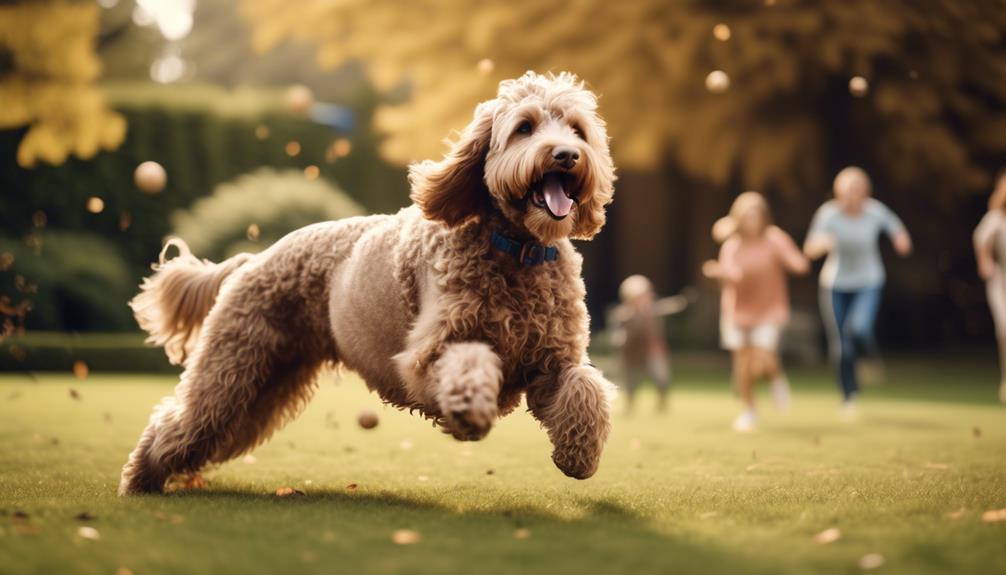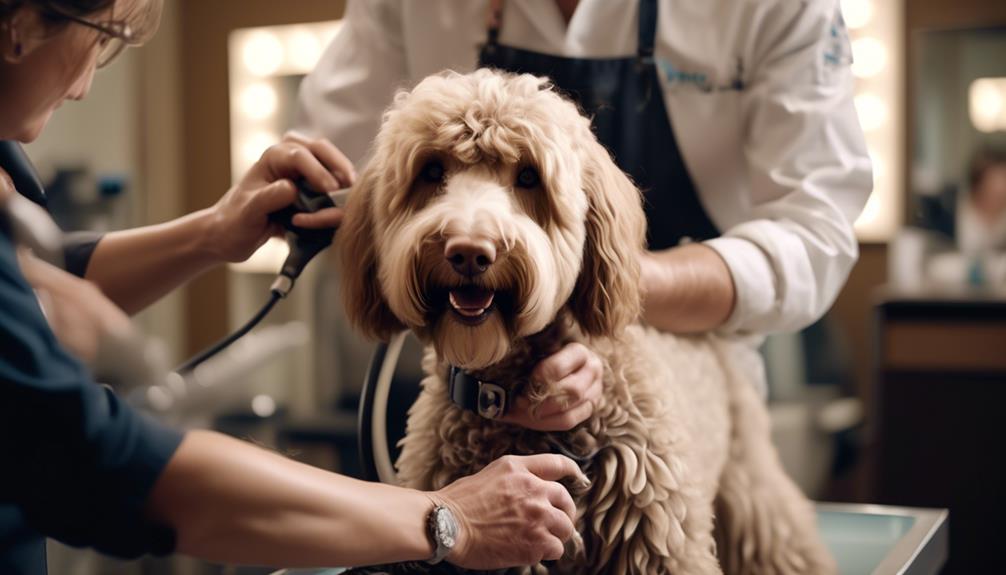With their Labradoodle, Jake, by their side, the Smith family embarked on a hike through a picturesque forest. As Jake happily bounded ahead, his curly coat glistening in the sunlight, it became evident that Labradoodles are truly a breed of endless possibilities.
But what makes them so special? What unique characteristics and traits do these mixed dogs possess? In this article, we will explore the fascinating world of Labradoodles, uncovering their origins, discussing their size and coat characteristics, delving into their temperament and trainability, and providing valuable insights into adoption and responsible breeding.
So, whether you're a dog enthusiast or considering adding a Labradoodle to your family, join us on this journey as we unveil the captivating information and characteristics of this remarkable breed.
Key Takeaways
- Labradoodles are a hybrid breed developed in Australia, mixing Labrador Retrievers and Poodles.
- They are friendly, intelligent, and highly trainable, making them suitable as therapy and assistance dogs.
- Labradoodles have moderate to high exercise needs and require regular mental stimulation.
- When adopting or purchasing a Labradoodle, prioritize ethical practices and responsible breeding to ensure the well-being of the dogs.
Origin and History
The Labradoodle breed has an interesting origin and history, as it was developed in Australia in the 1980s as a cross between a Labrador Retriever and a Poodle. The goal of this crossbreeding was to create a hypoallergenic guide dog for people with allergies.
Wally Conron, an Australian breeder, first bred the Labradoodle for the Royal Guide Dog Association of Australia. The original intention was to combine the intelligence and trainability of the Poodle with the friendly and sociable nature of the Labrador Retriever.
The Labradoodle quickly gained popularity for its hypoallergenic coat and friendly temperament, and it has since become a sought-after breed worldwide.
Today, Labradoodles aren't only beloved family pets but also highly valued therapy and assistance dogs.
Size and Breed Group

After its development in Australia, the Labradoodle breed quickly gained popularity for its hypoallergenic coat and friendly temperament, leading to a discussion on its size and breed group.
Labradoodles are considered to be a medium to large-sized breed. The size of an individual Labradoodle can vary depending on the size of its parents, which are usually a Labrador Retriever and a Poodle. Generally, Labradoodles range from 22 to 24 inches in height and weigh between 50 to 65 pounds.
In terms of breed group, Labradoodles are classified as a hybrid or designer breed. They aren't recognized by major kennel clubs as a specific breed but are recognized by designer breed registries.
Labradoodles have become popular among families and individuals looking for a dog with a combination of traits from both the Labrador Retriever and Poodle breeds.
Lifespan and Coat Characteristics

Labradoodles have an average lifespan of 10 to 15 years and possess coat characteristics that can vary in texture and shedding levels.
When it comes to their coat, Labradoodles can have curly, wavy, or straight hair. As for shedding, some Labradoodles have low shedding coats, while others may shed more.
Here are a few points to consider about the Labradoodle's coat:
- The texture of the coat can range from soft and fluffy to wiry and coarse.
- Labradoodles with curly or wavy coats tend to have a lower shedding level.
- Labradoodles with straight coats may shed more, but it can vary from dog to dog.
Understanding the coat characteristics of Labradoodles can help potential owners choose a dog that fits their lifestyle and preferences.
Temperament and Trainability

Developing an understanding of the temperament and trainability of Labradoodles is essential for potential owners. Labradoodles are known for their friendly, intelligent, and social nature. They are quick learners and excel in obedience training, making them suitable as therapy and assistance dogs. With their affable nature, Labradoodles are highly trainable and respond well to consistent, positive reinforcement methods. They have moderate to high exercise needs, requiring regular walks, playtime, and mental stimulation. Labradoodles enjoy activities such as fetch, agility, and swimming. Additionally, regular grooming is needed to prevent matting. To provide a quick overview of the breed's temperament and trainability, a table has been included below.
| Temperament | Trainability |
|---|---|
| Friendly | Highly trainable |
| Intelligent | Quick learners |
| Social | Excels in obedience training |
| Affable nature | Responds well to positive reinforcement methods |
Adoption and Responsible Breeding

When considering adopting a Labradoodle or purchasing a Labradoodle puppy, it's important to prioritize responsible breeding practices. To ensure the well-being of these dogs and discourage unethical breeding practices, here are a few guidelines to follow:
- Prioritize adopting from rescue organizations or shelters. This gives a deserving Labradoodle a second chance at a loving home.
- If purchasing a Labradoodle puppy, choose a reputable breeder. Look for breeders who prioritize health and temperament, conduct necessary health screenings, and provide a nurturing environment for the puppies.
- Ensure the breeder follows ethical practices. Reputable breeders should be transparent about their breeding program and be willing to answer any questions you may have.
Adaptability and Considerations for Apartment Living

Adaptable to various living environments, Labradoodles can thrive in apartment settings with proper considerations. While their size alone shouldn't be the sole determinant for apartment suitability, factors such as energy levels and behavior towards neighbors should be taken into account. Labradoodles with qualities like quietness, low-energy, and good manners in shared spaces are ideal for apartment living.
Creating a harmonious living environment for everyone involved is essential. Labradoodles require regular exercise to prevent boredom and destructive behavior, so daily walks and playtime are important. Additionally, mental stimulation through interactive toys and training sessions can help keep them engaged and content in a smaller living space.
With proper exercise, training, and socialization, Labradoodles can adapt well to apartment living and provide great companionship to their owners.
Health and Care Guidelines

Labradoodles require regular grooming and attention to their health needs for optimal care. To ensure the well-being of your Labradoodle, follow these guidelines:
- Regular grooming: Labradoodles have different coat types, ranging from curly to straight. Regular brushing is necessary to prevent matting and to keep their coat clean and healthy.
- Health screenings: Labradoodles are prone to certain health conditions such as ear infections, hip dysplasia, epilepsy, and allergies. Regular vet check-ups and necessary health screenings are important to catch and address any health issues early on.
- Exercise and nutrition: Labradoodles need 30 to 60 minutes of exercise per day. Provide them with a balanced diet of high-quality dry food divided into two meals. Regular exercise and a healthy diet contribute to their overall well-being.
Frequently Asked Questions
Are Labradoodles Hypoallergenic?
Labradoodles are often considered hypoallergenic due to their low-shedding coats. However, individual reactions vary, and it is recommended to spend time with a Labradoodle before bringing one into a home with allergy concerns.
What Is the Average Weight Range for Labradoodles?
The average weight range for Labradoodles is between 50 and 65 pounds. They are a medium to large-sized breed and can vary in weight depending on factors such as genetics and individual metabolism.
Can Labradoodles Be Left Alone for Long Periods of Time?
Labradoodles should not be left alone for long periods of time. They thrive on human companionship and may become anxious or develop behavioral issues when left alone for extended periods. Regular exercise and mental stimulation are also crucial for their well-being.
How Often Should Labradoodles Be Groomed?
Labradoodles should be groomed regularly to prevent matting, with the frequency depending on their coat length and type. Regular grooming is important for their overall health and well-being, ensuring they stay clean and comfortable.
Do Labradoodles Have a Strong Prey Drive?
Labradoodles can have a strong prey drive, but it varies among individuals. Proper training and socialization from puppyhood can help manage this instinct. It's important to monitor and address any signs of excessive prey drive to ensure a safe and harmonious environment.
What Are the Characteristics of Labrabull Mixed Dog Breed Compared to Labradoodle?
The labrabull mixed dog breed is known for its loyalty and protective nature, making it an excellent family pet and guard dog. In comparison, the labradoodle is more sociable and enjoys being around people. Both breeds are intelligent and require regular exercise to stay healthy and happy.
Conclusion
In conclusion, Labradoodles are a popular and versatile breed known for their friendly nature, intelligence, and low-shedding coat. They excel in obedience and make excellent therapy and assistance dogs.
Labradoodles adapt well to apartment living but require regular exercise and mental stimulation. Responsible breeding and adoption are important to ensure the well-being of these dogs.
With proper care, Labradoodles can live a happy and fulfilling life, bringing joy and companionship to their owners.




